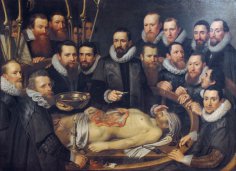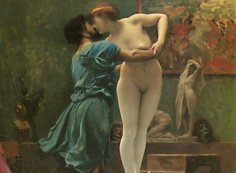
Once upon a time there lived an ivory carver named Pygmalion. He wouldn't have stood out from the crowd if he hadn't become satiated with women. After that, he apparently fell into depression, which led to him remaining alone for a long time.
This is how Ovid tells it in Metamorphoses (book 10, verses 243-297):
… single, lonely
He lived, and his bed was deprived of a companion for a long time.
But somewhere deep in his soul, in his subconscious, lurked the image of a woman of unrivaled beauty. It's possible he'd seen her, perhaps more than once, perhaps even been as close to her as he could have been, but her depravity had driven him to distance himself from her. Some time passed, and a yearning for love overcame him:
And he created an image, similar to
The world had never seen a woman, and he fell in love with his creation.
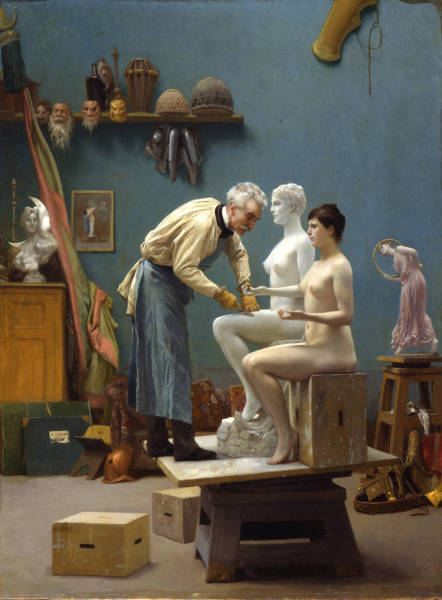
The carver was so skilled that his creation seemed alive to him. He couldn't believe his eyes, and he touched his creation to make sure it was bone and not a living body.
At some point he seemed to go crazy:
He kisses the girl and thinks that it is mutual; he addresses her with speech,
He touches it and it seems to him that his fingers are pressing into the body,
He is afraid that a bruise will appear on the affected area.
What power his passion had! And then it gets worse: he imagines the statue responding to his gifts. He brings her shells, pebbles, puts on stone rings, and hangs a necklace around her neck.
In the end, he puts her to bed and treats her as if she were alive:
He puts on the covers, …,
The lodge calls her friend, her bowed neck
Undead on soft fluff…
It seemed he would never return to humanity—his fantasies had carried him so far. But the feast of Venus arrived, and the carver made a sacrifice to her and asked the gods:
“Since everything is available to you, O gods,
275 Give me, I beg, a wife (I didn’t dare to take that bone maiden
(Mention) so that it would be like mine, which is made of bone, similar!
By chance, Venus happened to be in that very place at that very time, and she understood the suffering of the man in love with the dead bone and gave a sign that he was heard.
280 Returning home, he runs to the desired image of the maiden
And, bending over the bed, he kisses, “Has it really gotten warmer?”
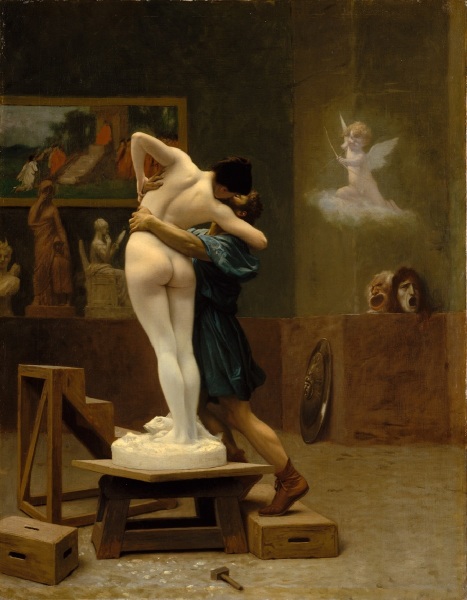
Pygmalion doesn’t believe his eyes and lips, he feels her:
The body before him! The veins throbbed under the pressing finger.
He was at a loss for words, but, slightly awakened by the happiness that had befallen him, he thanks Venus. And moves on:
Presses lips
He finally, to the genuine lips, feels the kiss.
It happened! The statue came to life! A wedding followed, and the bone carver and the former statue became husband and wife.
The story of the artist and his pursuit of perfection has been embodied in countless works of art, literature, and dance, as well as countless paintings, plays, performances, and films.
This story also appears in the paintings of the French artist Jean-Léon Gérôme (1824-1904). A sculptor is carving a marble statue, and a model stands before him.
In another picture: the session is over, the model can see what the sculptor has created.
Another scene: the statue is finished, it has come to life! Galatea—that's the woman's name (it's embarrassing to even call her a statue now!)—and Pygmalion, the sculptor, are embracing. Passion has overwhelmed them both; she hasn't even had time to step off the pedestal, let alone separate from it! And Cupid appears as if from a cloud, aiming his arrow at them.
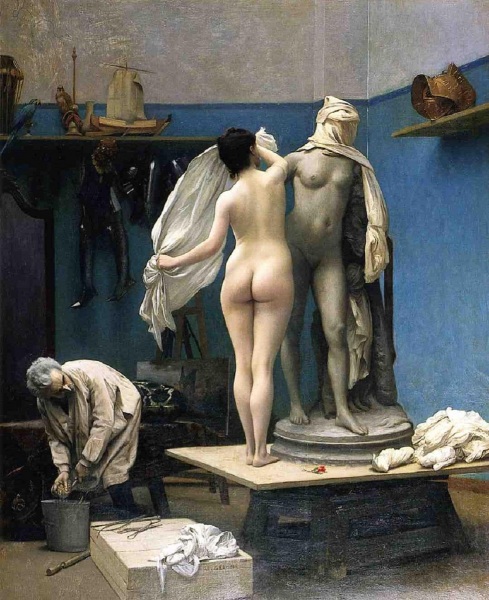
The artist injected a note of uneasiness into his painting: beneath Cupid lie two tragic theatrical masks, screaming loudly at the top of their lungs. A hint of what? That the woman carved from marble will never truly come to life and that the artist should not delude himself? Or are these simply artifacts from the sculptor's workshop that accidentally found their way onto the canvas?
A beautiful tale about how mad love can bring even a statue to life…
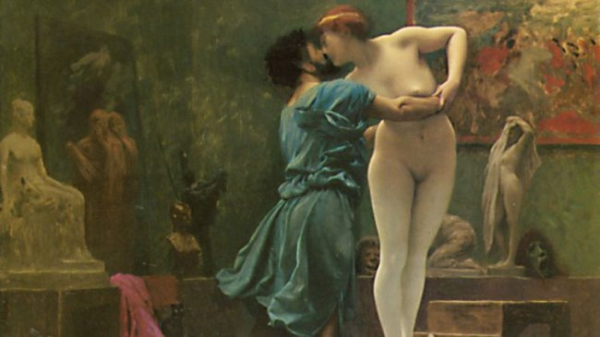
Pygmalion and Galatea, Jean-Leon Gerome
P.S. What we see in the painting “Pygmalion and Galatea” could well have happened between the model and the sculptor (this was vividly described in his biography by the great Italian jeweler and sculptor Benvenuto Cellini).


